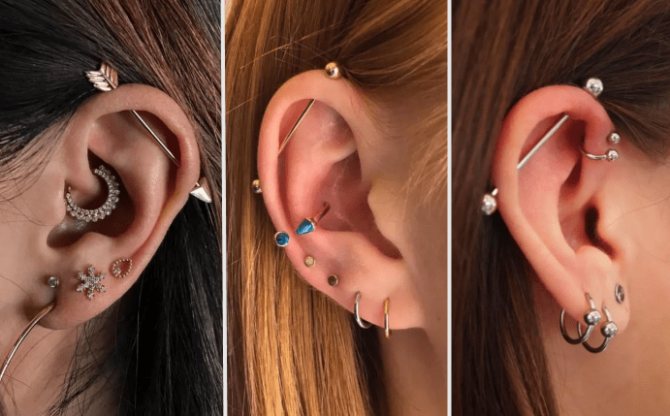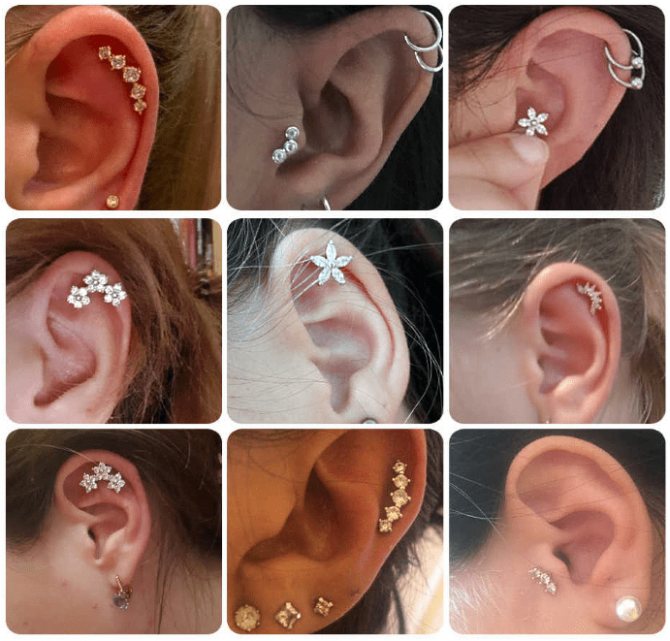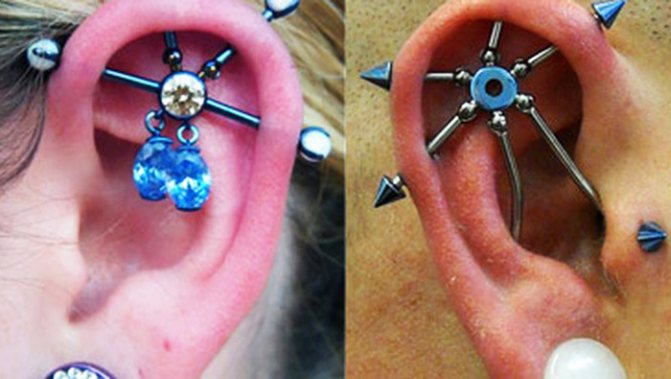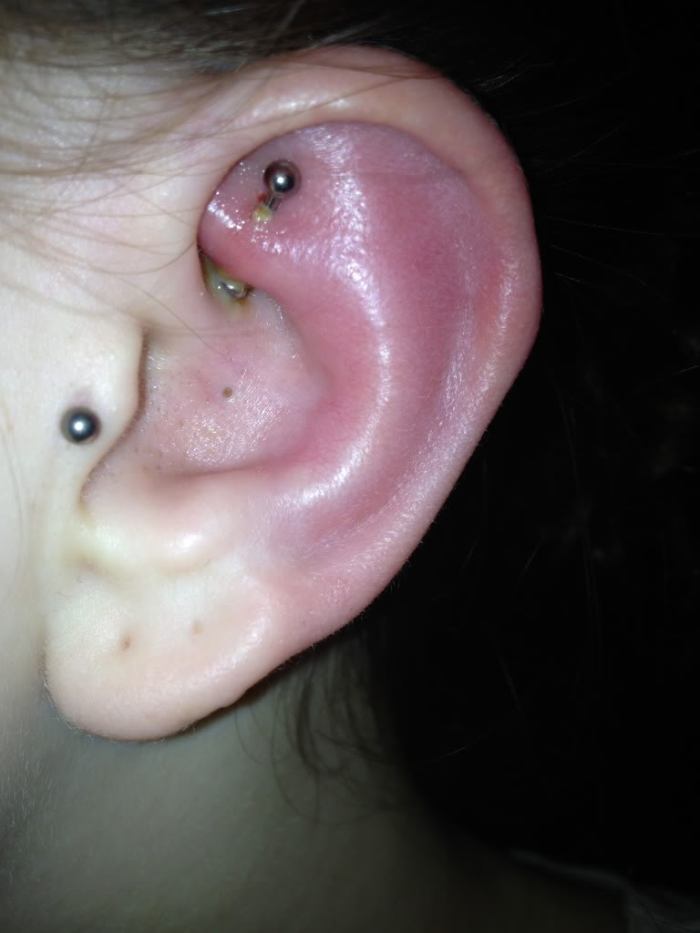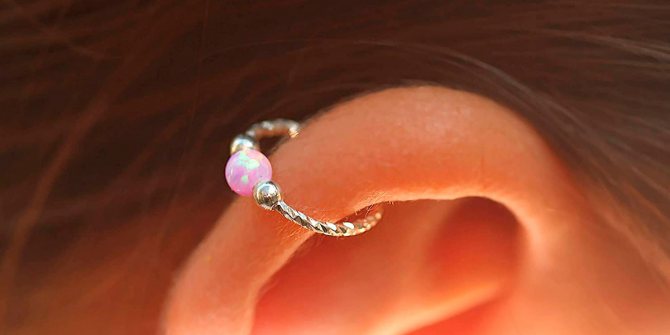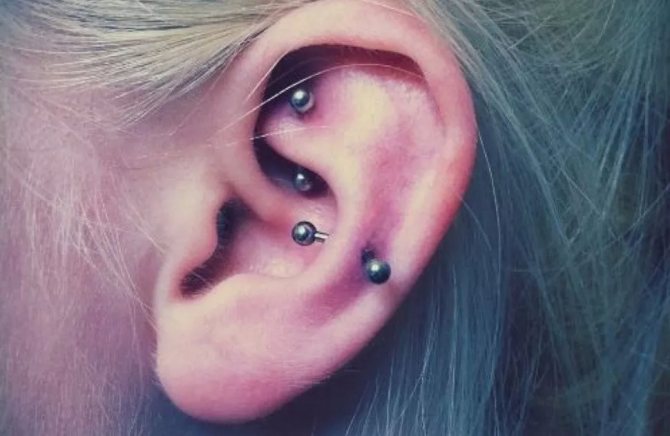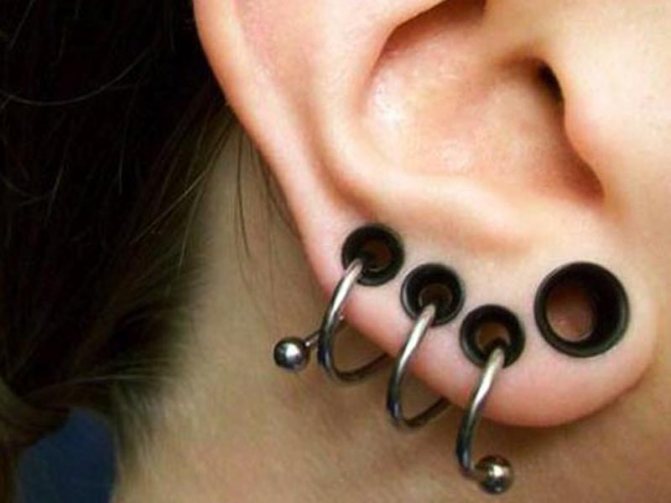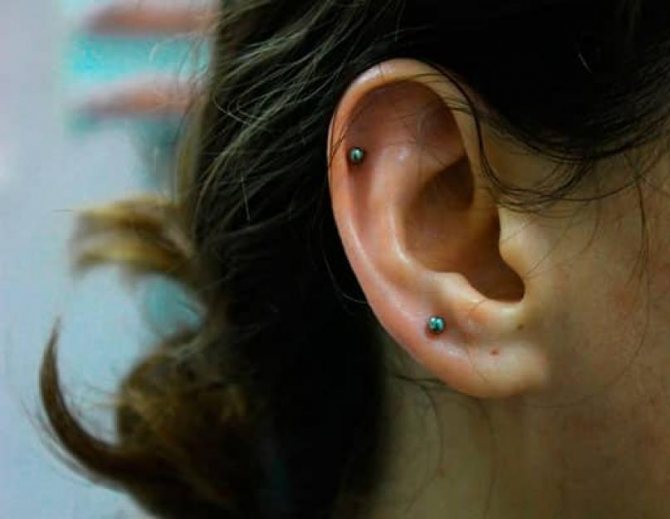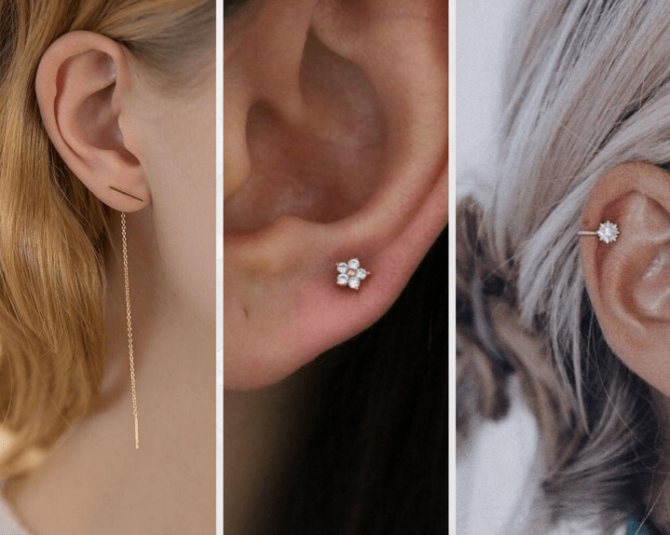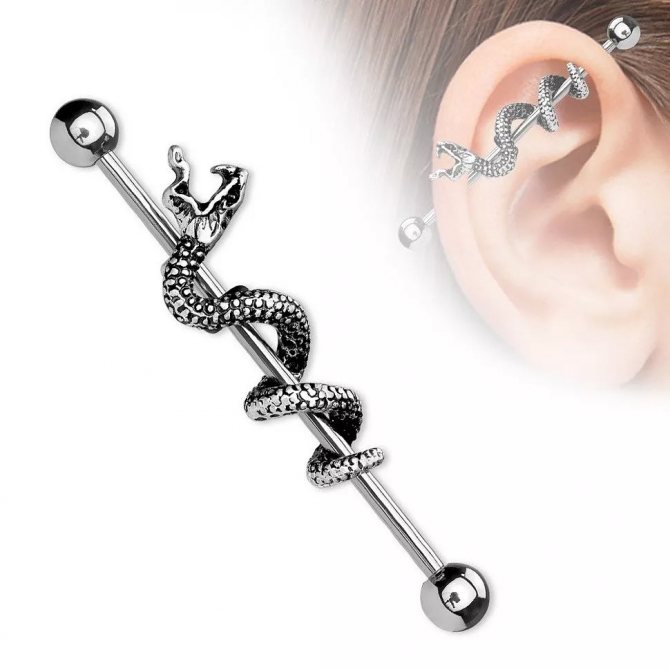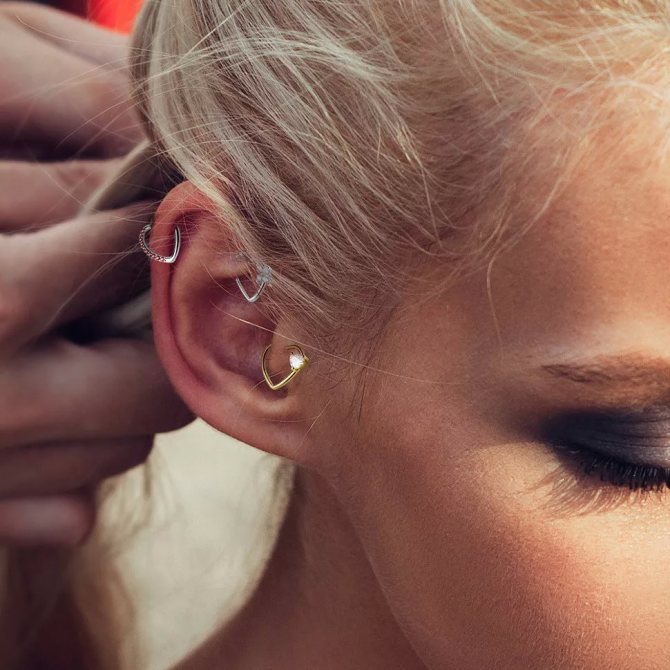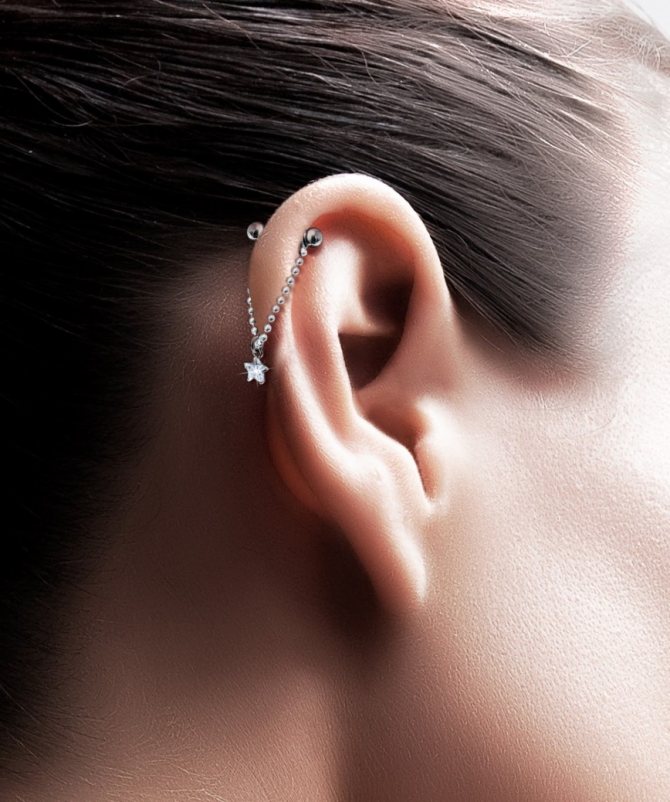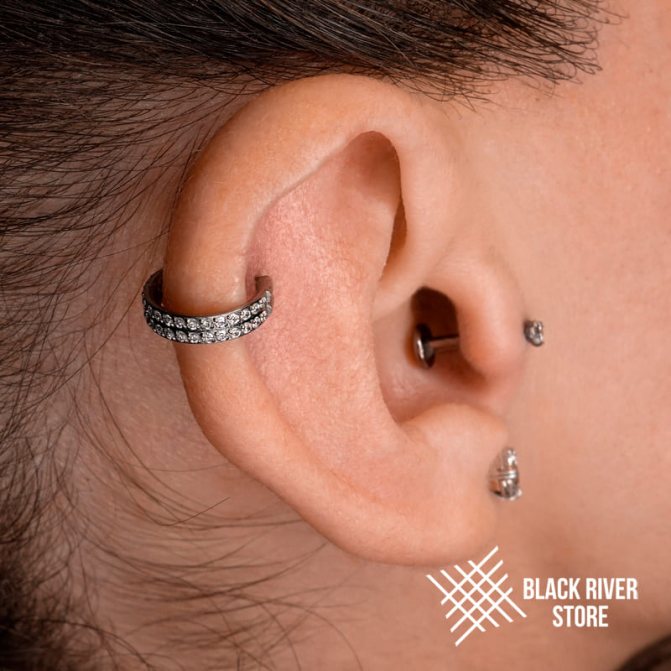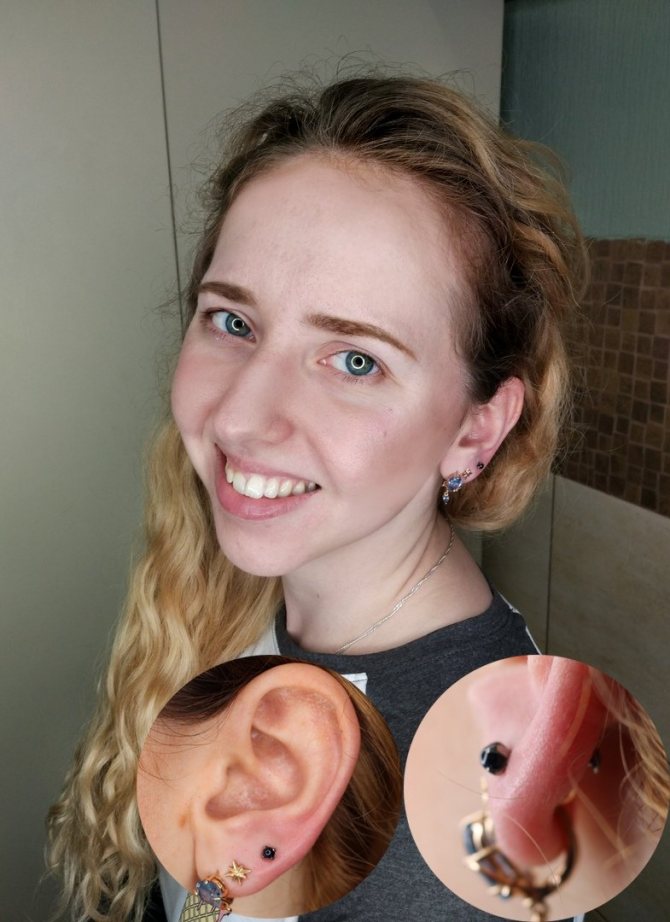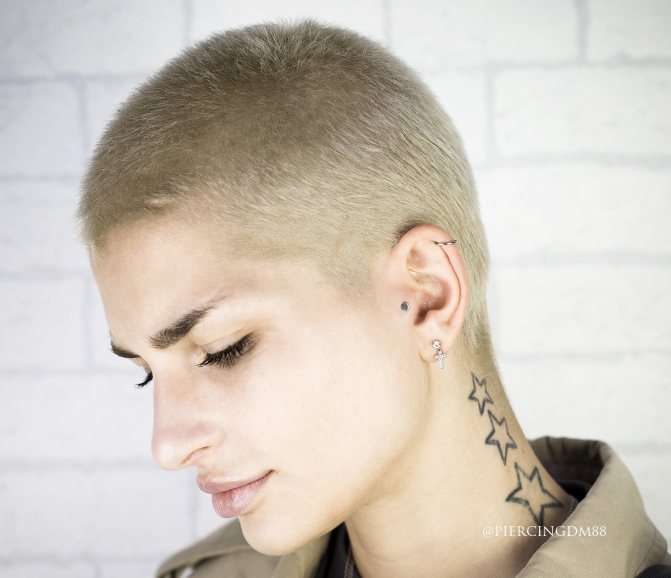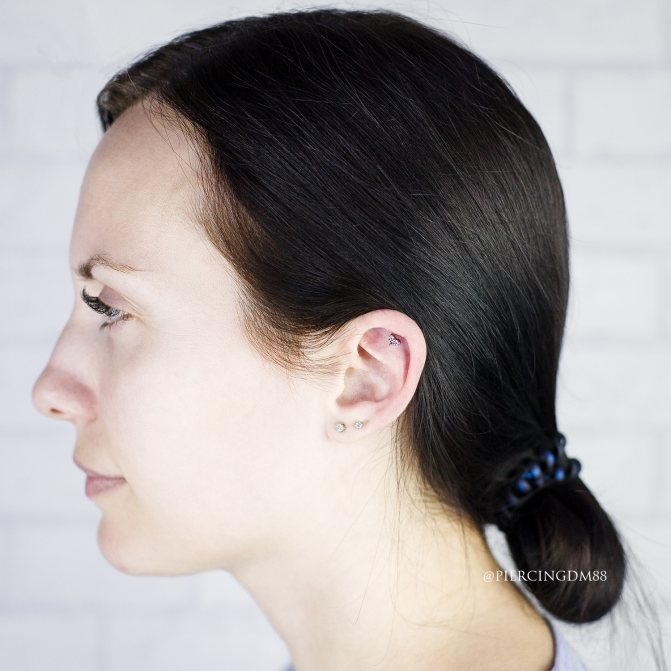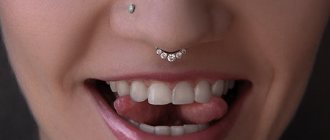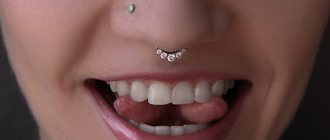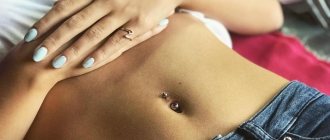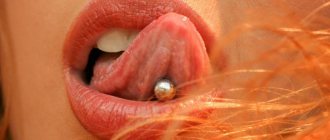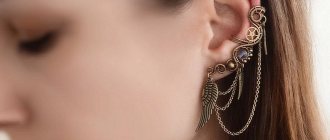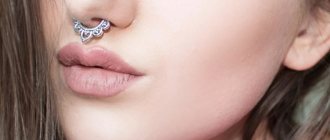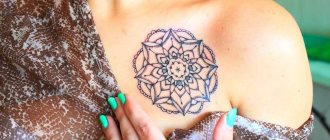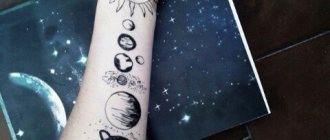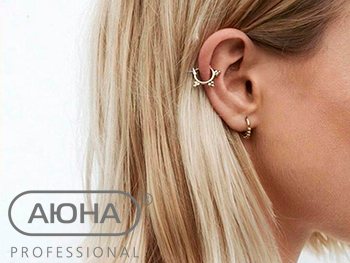
This type of piercing is used when the cartilage part of the ear is pierced. Cartilage piercing and its consequences differ from conventional earlobe piercing with a needle or gun.
Instruments for ear cartilage piercing: Catheter needle (the number depends on the diameter of the jewelry), end clip, ring clip and ring clip.
Cartilage piercing earrings: ring, barbell, circular.
Treatment before the procedure: Before marking, the ear is wiped with 95% alcohol. The jewelry is dipped into a solution of antiseptic for 15-20 minutes (95% alcohol, disinfectant solutions).
Puncture site: the point is placed with an aseptic marker.
What is the name of the cartilage puncture
Picture is taken from one English speaking website and names do not change because they are all pronounced without translation, although words like lobe need translation of course
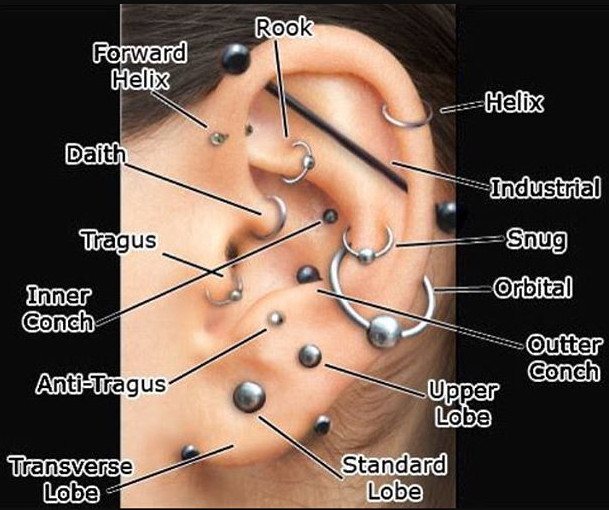

The most popular species in CIS countries are:
- Tragus
- Helix
- Industrial
- Orbital
From the picture we can also see complex punctures, you can identify them by touching your ear. For example, there is dense cartilage in the ear bend areas. And rook in general requires the puncture of two cartilages at once, and in addition it is difficult to get to them. It is certainly not something that a dilettante can do.
Which earring should I choose?
Initially, before the piercing, decide on the thickness of the earring, because the hole in the cartilage is not stretched as in the case of the lobe.
- One of the most popular choices is a barbell or barella. The optimal solution for the piercing type of industrial. Visually it is a tube with retainers, it does not bend. The decorations are varied - stones, studs and other decorations.
- A ring is a standard type of earring for both cartilage and lobe. The circle is not closed, there is a balloon insert or other decoration in place of the missing part.
- Labret-decorated stick, similar to a pousseta. The straight wand is bounded by discs on each edge.
- Circular-a horseshoe that is terminated with balls on both edges.
- Banana - an earring of a characteristic shape, with a twist - a ball or cone - on both ends.
Beautiful photos
Of course most of the beauty gives the earring itself and jumping ahead to say that buy it before you're going to pierce something
Tragus
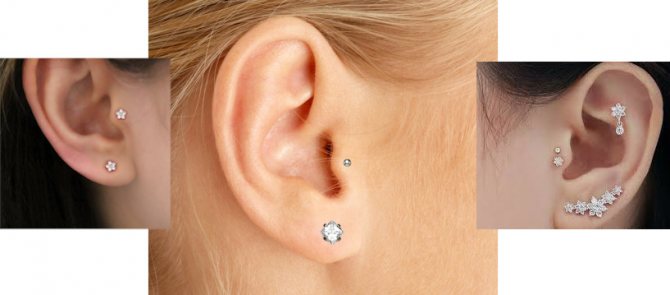

Helix
It may seem that it is easy to do, and therefore there will be no complications. As if not, in violation of the fundamental principles of the piercing happen unpleasant complications.
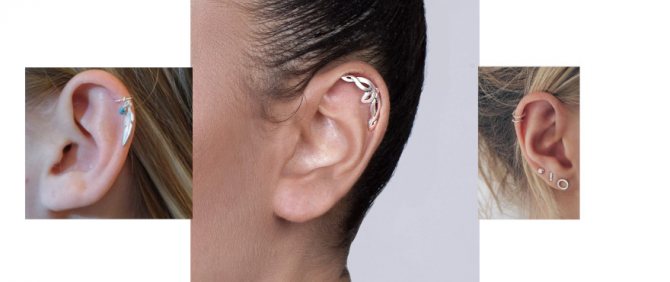

Industrial
This is the most popular piercing in our country, probably because of this in the network you can see many reports of complications
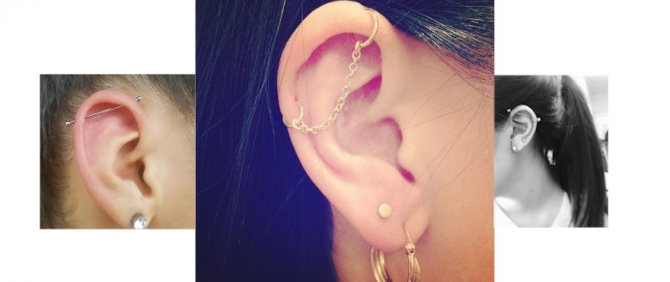

What are helix piercings?
Ear piercings have a special place in the piercing industry and are incredibly popular. There are many types of ear piercings, and one of them is chelix. Helix piercing what it looks like: a helix is a piercing of the upper cartilage of the ear. At the moment, this piercing is one of the most common, there is even a fake chelix piercing. The right place allows you to wear almost any piece of jewelry and create compositions of several piercings . In this article, we will tell you about all the nuances of helix ear piercing, the procedure and healing.
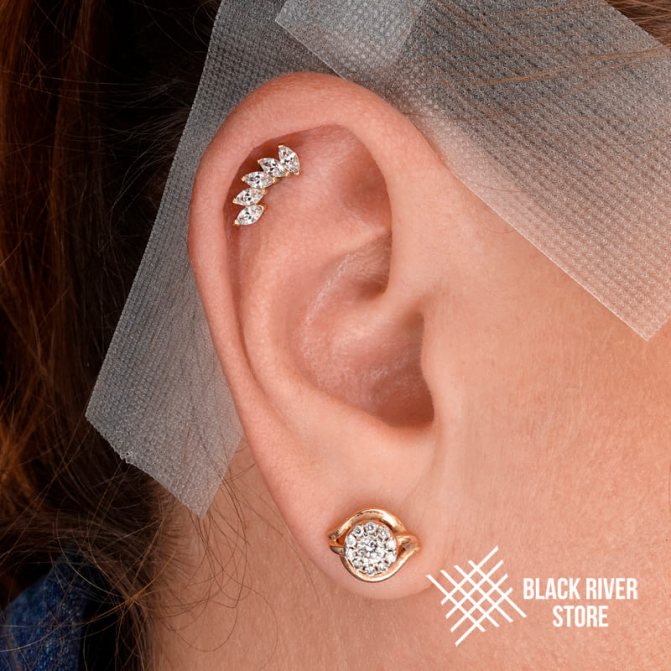

What we will need
The first thing we will need is a second pair of hands that will gladly make a hole in us, or even two. To hold a clamp, to make a piercing, and then even in the needle to insert an ornament that would not accidentally prick a finger - it is necessary to know how to do it.
Needles for piercing, disposable clamp and bioplastic labret can be bought on aliexpress
- Antibacterial soap
- Non-toxic marker
- Disposable gloves
- Saline solution
What kind of earrings do you need?
This section is divided into two parts, secondary and primary jewelry. You must have the first and the second in advance to know what diameter the needle should be.
Secondary jewelry is something that you will wear after the full healing of the puncture and not before. You can choose any material that you are not allergic to.
The primary jewelry
My recommendation is to use a bioplastic labret. as it is one of the two approved materials for primary jewelry.
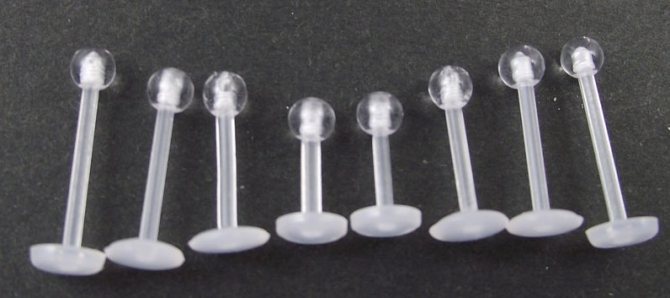

Flexible is great, bioplastic is great.
The second approved material is ASTF 136 implantable titanium. But if you buy such a thing, it is desirable to see the documents on the goods, because even ordinary surgical steel is passed off as such.
Why you can't use surgical steel
Because it exceeds the value of nickel concentration. The allowable value is 0.05%, and in surgical steel 316L/LVM from 0.10% to 0.25%
Do not buy any metal jewelry on aliexpress as there is a chance to run into poor quality and on such products even the polish is not smooth, and this is super evil for us
Piercing with a gun or needle
The piercing needle is always in a sterile and airtight package, and also runs smoothly through tissue (if you use a clamp)
The primary jewelry and needle must be larger in diameter than the secondary jewelry. For example your primary jewelry has a diameter of 18g, the needle and primary jewelry should be larger, hence 16g
Is it possible to use a disposable gun
The point is that the jewel in the gun will never be as well polished as the needle, nor is it as sharp as the leads to the formation of keloids in the healing process. And it can also crack the cartilage, and the bruise can be said to appear simply because the procedure is not done smoothly.
Clamp
Disposable clamps on alike are sold in a sealed package and ready to use right away.
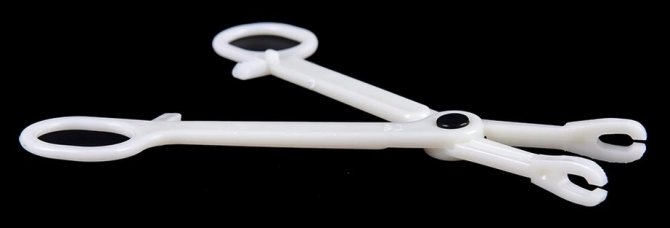

This is a very important device and helps to hold the victim firmly, otherwise at the sight of a needle they always tend to jump out the window. And seriously, you will see a picture below with a bruise and that can be because the clamp was not used.
Earrings for ear piercings
To heal quickly, it is important to choose the right earring for a particular piercing. Beautiful jewelry is not always appropriate and comfortable, so this should be thought through in advance.


Types of stud earrings for piercings
Types of earrings for ears:
- Carnations. Classic jewelry. Suitable for pierced earlobes in children or for the design of numerous holes on the cartilage;

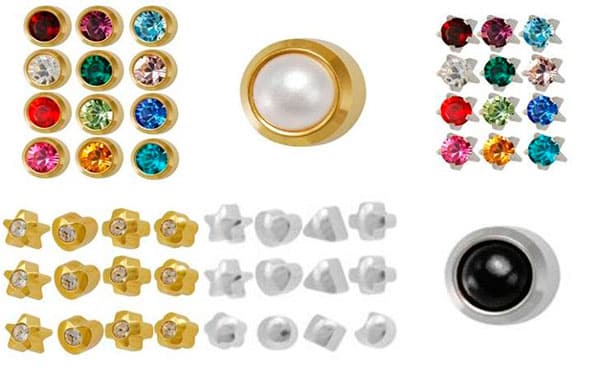
Carnation options. - Rings. Promote rapid healing. Their shape makes them very easy to care for;

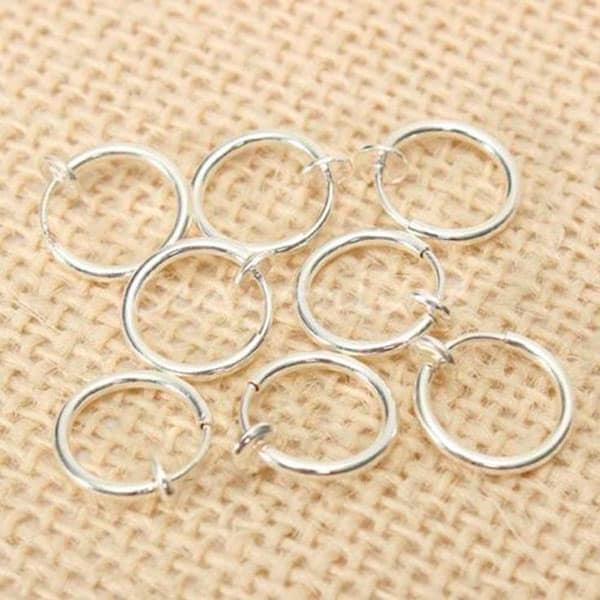
Unusual piercing rings. - Rods. They consist of balls on the edges and a flat pin in the center. It is also, like the rings, easy to care for. Suitable for industrial and antihelix;

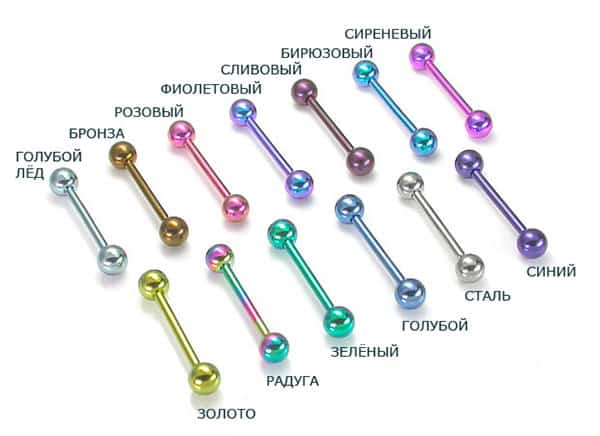
In-ear rod options. - Snails. Extremely rare ear jewelry because of the unusual shape, but if made by Daze, it is the best choice. They allow you to hide puncture marks and are very tightly fastened - definitely not lost.

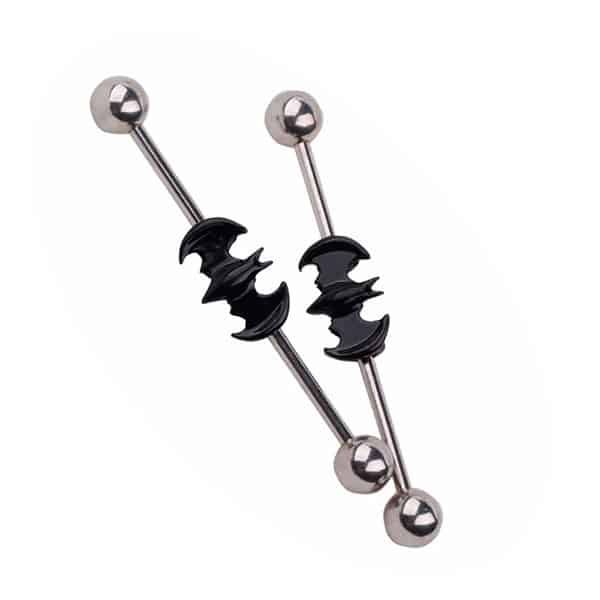
The barbell for the industrial.
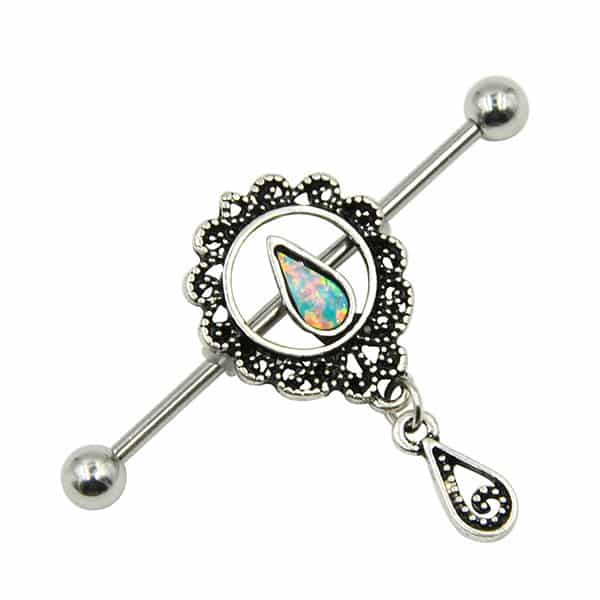

Earring for multiple punctures.
By material are divided into plastic, metal (steel, nickel, titanium) and noble (gold, platinum and silver). Plastic has various contraindications because of the high roughness of the surface. Some girls say that this material slows down healing.
How to disinfect jewelry and tools at home
I know for a fact that you can kill HIV, Hepatitis B and C with a MIRAMISTIN. But I can't tell if it will work with Hepatitis A and yet it is afraid of UV light and dies in a couple of minutes.
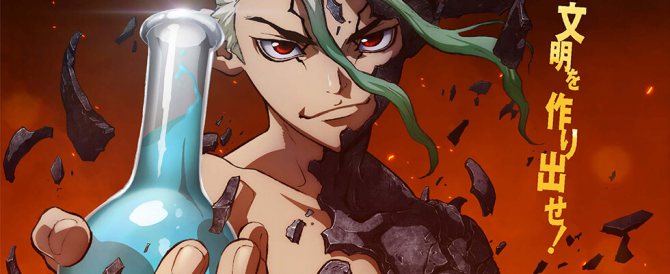

Miramistin is everything.
A combined approach of miramistine and ultraviolet light will kill all the nasty stuff that's out there.
Boiling
This is a must have because all these viruses and hepatitis are not resistant to external influences. The most resistant in this list is Hepatitis B that needs 30 minutes of boiling.
Preparation for the piercing procedure
The place of piercing is preliminarily examined by a specialist to assess the location of vessels, anatomical features of the ear.
The main point is that the ear cartilage piercing is painful and more complicated than the piercing of the lobe. Before piercing, start with the lobe.
- First, the entire ear is disinfected by treating it with 95% alcohol.
- The jewelry itself, which will be inserted immediately after the piercing, is disinfected: for this purpose, it is treated in an autoclave (dry fire), which allows to kill 99.9% of germs. The disinfection process takes 15-30 minutes.
- The puncture point is dotted with a special antiseptic marker and anesthesia is administered.
Since the procedure is quite painful, local anesthesia is used: external, injected or both together. A special cream or spray is applied to the skin as an anesthetic, then an injection is injected. Sometimes only external anesthesia is enough - it all depends on the puncture site and the client's pain threshold.
When can we pierce the ears
If we're talking about the time of year, we wrote about it here. And yet we'll say it again by saying that Spring and autumn is the best time for piercings.
State of health
All of this is done only when you don't have that question: 'Can I do it if I don't feel well? You have to be completely healthy and the first weeks of healing should go smoothly, and better the first couple of months.
Contraindications
There aren't many, but they are there and on that list of course is pregnancy and underage. If you have even a slight suspicion of not doing it then go to your therapist and he will advise you. There is no charge for simply going to him.
- Clotting disorders
- predisposition to allergies
- otitis and other ear ailments
- mental disorders
- Viral, infectious forms of illnesses
Just do not exercise, go to the pool and swim in other bodies of water
Stages of the piercing procedure
- If there are no contraindications to the procedure, the specialist makes preparations: the specialist examines the features of the ear, disinfecting the ear with alcohol, the place of the piercing is marked with a special marker. Some puncture sites are much more painful than others. An anesthetic may be used.
- Fixation with the instrument - using a clamp.
- A catheter needle is manually pierced through the cartilage - the needle is removed, leaving the catheter.
- Then a previously disinfected jewel is inserted into the catheter, and it is gradually pushed out by the earring.
- Finally, the catheter is removed from the stem and the balloon is screwed on the earring.
What can be the consequences of ear piercing
I'll only mention the two most common and they are keloids, bruising and swelling.
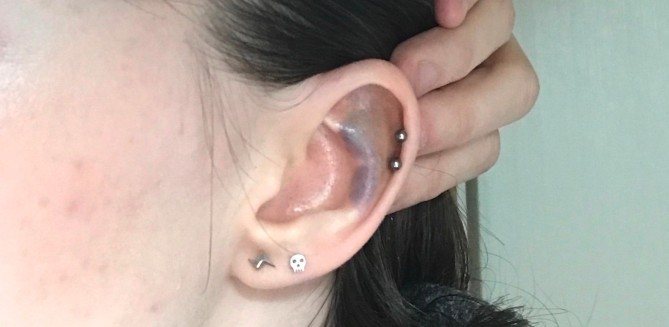

This is a consequence of not only rough work but also negligent care of the perforation of the wearer himself.
Keloid
A bump on a cartilage puncture tells us about keloid, which is treated only after the ear is completely healed.
You can fight it for two years or even more. It is harmless, but not beautiful and represents a growth of the skin.
If there is keloid with pus, it is already a granuloma and tells us about the infection.
How to treat
Keloid is treated with pure tea tree oil after the ear is completely healed.
What to do if your ear is swollen
The swelling is a reaction of rejection of the jewelry, are you sure you have a quality product that consists of bioplastic or implantable titanium? It could also be from a bruise.
In any case, do not pour there all the ointments you know, or rather ointments do not need to be used at all. You need antiseptic and saline and regular treatment a couple of times a day.
Types of ear piercing
Professional masters of piercing distinguish 34 types of ear piercings. Variants are classified by location.


Ear piercing with a gun
The most common are the following types of ear piercings (with photos):
- Lobe piercing.
. The softest part of the ear is pierced. Healing is similar to any other piercing of fleshy areas of the body;
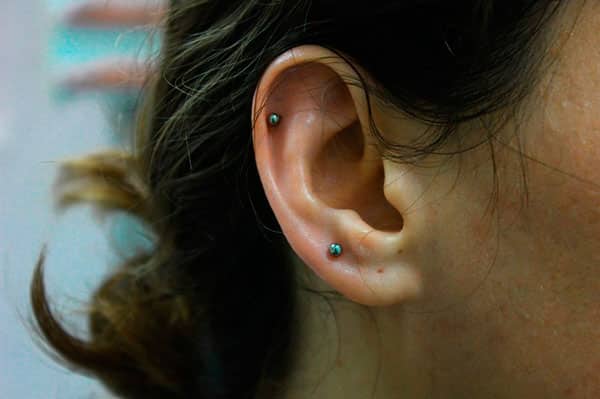
Lobe Piercing - Helix
. The hole is made in the upper part of the helix of the auricle. No pain is felt during it, because there are no nerve endings in the cartilage;
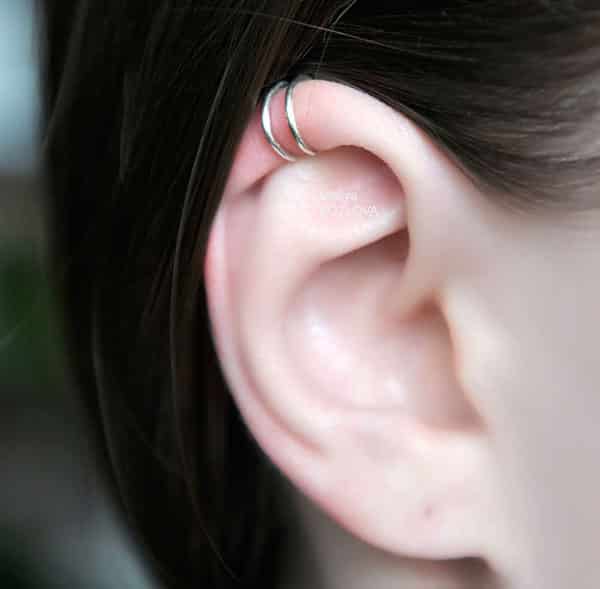
Helix puncture. - Anti-Helix or Snug piercing .
. It is done in the upper cavity of the auricle. Unlike the regular chelix, here the cartilage is pierced in two places;

Snug piercing - Upper chelix.
Is an ear piercing located at the top of the helix of the auricle, as close to the head as possible. Because of the difficulty of performing it is done very rarely, of the jewelry used, mainly carnations; - The most complex type of ear piercing is Daith
. Its meaning is related to the acupuncture teachings of India. They say that it is not just an adornment of the body, but to provide protection for the "vessel." To make a Daith, you need to prepare a special curved needle that can pierce the middle ear cartilage. The location of the earring plays a decisive role in such piercings: if holes are visible, Daith is considered of poor quality;

Daith earring - The tragus or goatee.
. Got its name because of the location. This piercing is believed to be very painful, although it, like many other types of piercings, is located in the cartilage;
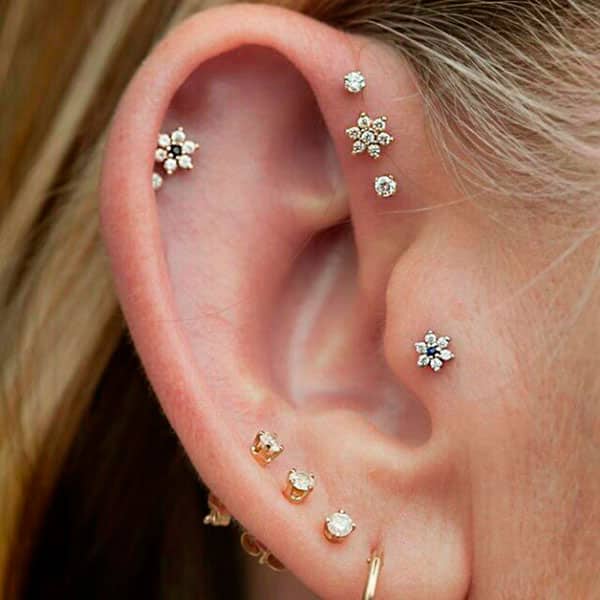
Tragus - The piercing of the lower part of the auricle or anti-corneal piercing
. The ornament can also be placed in the curved cartilage of the curl;
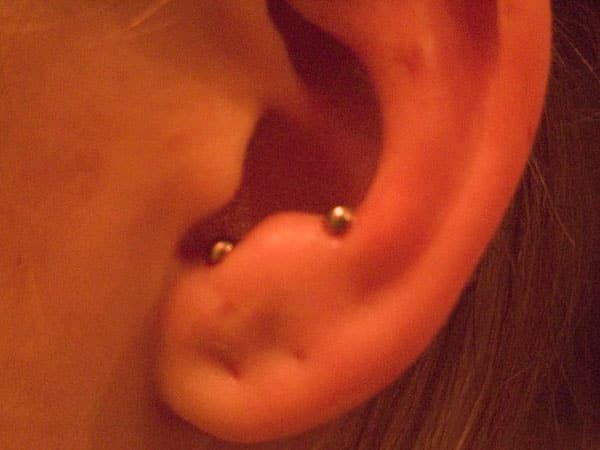
Countercone - Industrial
. A professional ear curl piercing in which two piercings are made. They are then connected to each other with a long earring - a barbell. For maximum convenience, the pierced points should be parallel to each other. Although, occasionally, it is allowed to raise the second part of the earring just above the location of the first hole;
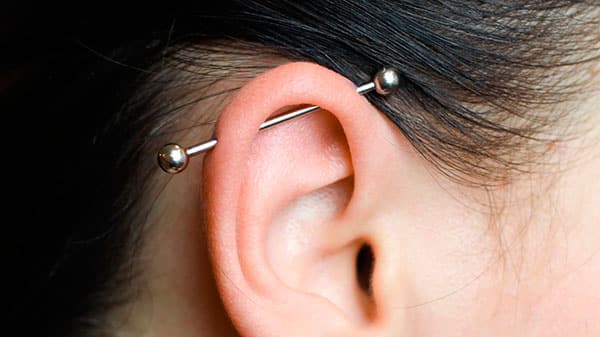
Industrial piercing - Rock
is very similar in appearance to the anti-piercing, but differs in the lesser requirements for the earring insertion holes. The decoration is placed on top of the tragus, in the auricle;
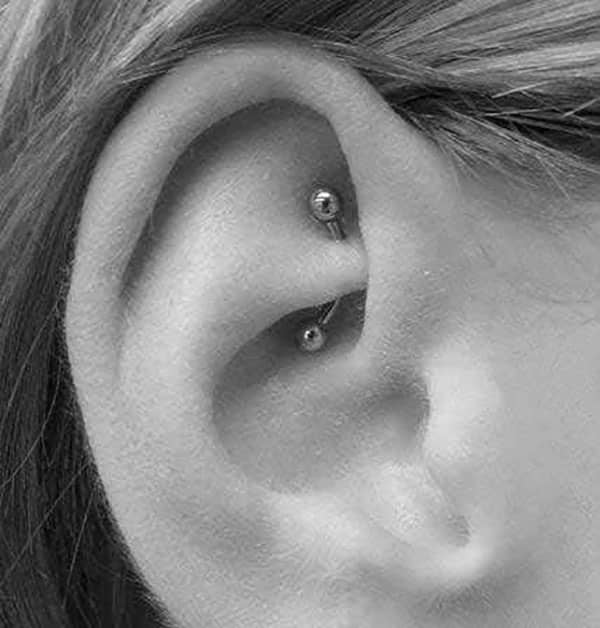
Piercing Rock - Fallout
. The peculiarity of this piercing is the layout of the earrings. Most often, several parallel Helix piercings are made, and then rings of equal diameter are inserted into them.
How long does a cartilage piercing heal
Simple punctures heal from three months, and complex from six months. It is worth focusing on exactly six months. The longer you wear your primary jewelry the better, and I totally understand your desire to get your jewelry in there as soon as possible, but you are in no hurry.


My Pretty.
When can I change my earrings?
If the piercing was a simple helix, tragus or forward helix, then it's about two months, but you need to make sure that you don't have any biological secretions that might react with the metal.
On average, of course, it is three months of active care and monitoring of the process, the longer the better. Newly formed skin is thin and can easily crack and begin to release lymph, which is fraught with the consequences of interaction with the precious jewelry.
What to treat with
The first two weeks are the most difficult, at which time a more reverent care is required. And the treatment itself is an extremely complex activity, as The use of an antiseptic for 14 days leads to dysbacteriosis. and to avoid this you need to wash with saline.
You have treated with MIRAMISTIN and in 15 minutes you can rinse with saline
Why just MIRAMISTIN and not CHLORGEXEDINE?
The former is a unique super product! Let's all split up.
It retains activity when interacting with blood, pus and biliousness. Chlorine cannot do this and its activity goes down. It can also stimulate local immunity and our superhero can and that is what makes the super fast healing effect.
Chlorhexidine has side effects such as dry skin and itching, and our superhero does not. By the way, in the first stages of healing, the piercing will itch and this is normal.
Ear cartilage piercing care
EAR CARTILAGE PIERCING CARE TIPS (HELIX, CONCH, LOW HELIX, TRAGUS, ANTITRAGUS, DAITH, FORWARD HELIX, ROOK)
Where does ear piercing hurt the most?
The pain of an ear piercing will be the same no matter which type of piercing is chosen. As for the level of pain - there is no need to fear the piercing in this area, because if the master knows what he is doing, it will not take more than a second. The client will not even have time to understand what has happened, and will feel almost no pain.
How long does it take to heal?
Complete healing usually takes about 6-12 months.
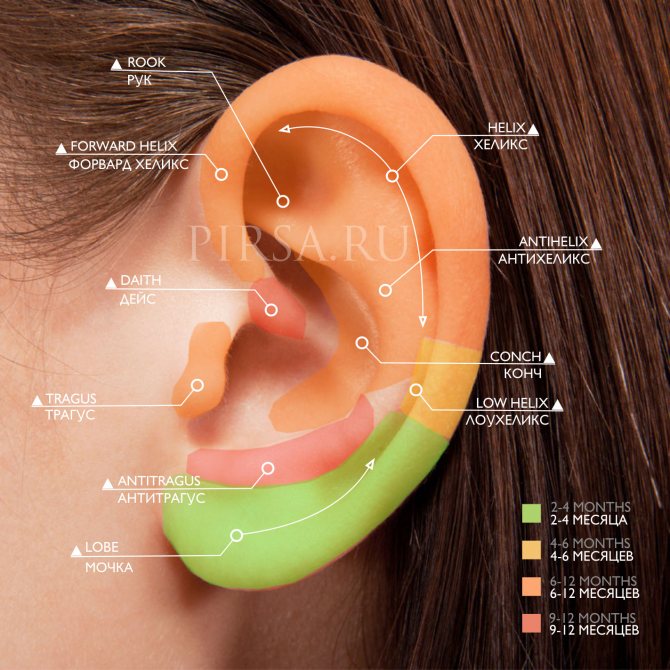

What kind of jewelry is appropriate for a fresh piercing?
The type of jewelry depends on where the piercing is done. If it is "Flat", "Tragus" or "Helix", it is necessary to put a labret, it will be possible to change it for a ring only after the primary healing. But if you pierce a "face," then the primary jewelry is the opposite of the ring. In "industrial", an elongated bar is placed. The ruuk is a banana.
How long will the swelling last and how strong will it be?
The swelling is worst in the first couple of days. Your ear can almost double in size, but this reaction is normal and you should not be afraid of it. The swelling will not last more than a week or two.
Do I need to twirl the jewelry?
Twisting your jewelry is strictly prohibited, because irritation of a fresh wound can increase the healing time, as well as provoke an increase in swelling, pain, and even contribute to the entry of infection.
How long before I can wash my hair?
It is best to avoid contact with water for a few days after the puncture. Then you can take a shower, but it is important to avoid steaming the wound or getting soap or other products in it.
Can I wear headphones?
If a puncture has been chosen on the outer curve of the cartilage, such as Helix, you can wear earphones, if Dace, you can wear earbuds. But in other cases, you will have to give up wearing them.
How to take care of?
Puncture is a wound, so it is necessary, firstly, not to interfere with the process of recovery, and secondly - to keep the wound clean. You need to avoid street dust, do not touch with dirty hands. Following the rules of care will help avoid infection and other problems.
For care, you will need a saline solution and a Band-Aid.
Pour the saline solution into a suitable container and immerse it in its entirety for three minutes, then gently remove the soaked secretions with a cotton swab. The remains of the solution must be rinsed with water.
It is necessary to moisten a cotton disc or tissue with Miramistin, and then put it to the puncture site for one to two minutes to disinfect it.
How will the puncture affect daily life?
It is important to promote the recovery process - eat right and sleep well, drink plenty of water, and maintain your immune system. All of this will help the body to focus all of its energy on the proper healing of the wound.
From the time of the puncture until the tenth day, you should rinse the wound twice a day, and make lotions with miramistine every time dust and dirt gets on it. Nevertheless, it is not recommended to use more than two or three times a day. The wound will need to be taped on both sides with an absorbent plaster - at first permanently, then only before going to sleep and when walking outside. At home and at work (if the room is clean), you can not tape the puncture, but be sure to exclude contact with any irritants.
From the eleventh to the fortieth day, treatment is carried out once a day. Saline solution can be replaced by weakly concentrated soapy water, it is not necessary to seal the puncture, but it is still necessary to exclude contact with external irritants.
After the fortieth day it will be necessary to replace the jewelry (downsize), because the primary healing is over, the swelling has subsided, and the wrong bar or labret can dangle and traumatize the piercing. It is important to remember not to wear jewelry made of unknown alloys and materials - this can cause redness and swelling again. Treatment should be carried out several times a week.
What should not be done with the piercing?
1. Do not rub or change the jewelry in any way. In order to speed up the healing, you need to disturb the puncture as little as possible. Also, if you take it out sooner than in a few months, it will lead to swelling and you won't be able to put it back in without help.
2. Do not use hydrogen peroxide, as well as alcohol-containing products, let alone pure alcohol, any ointments, homemade or purchased herbal remedies. All of these could cause chemical burns, irritation, allergies or infection.
It is necessary to prevent cosmetics and care products from getting into the wound, so as not to provoke allergies or inflammations. 4.
Limit (or preferably eliminate) the consumption of alcohol, caffeine and blood-thinning medications, as well as smoking. The influx of blood to the wound and the deterioration of the immune system will significantly slow down the recovery.
5. Do not visit swimming pools, baths and saunas for at least a month, and not a tanning bed for two weeks.
Do I need to have a puncture examination?
If in the first ten days there is severe swelling, which causes the jewelry to stick into the skin, you should visit the master for a replacement.
After the fortieth day, if the piercing is not a problem and the swelling has gone down, the jewelry should be replaced.
How do you know if a piercing is out of order?
1. The jewelry is digging into the skin - this is due to severe swelling. In this case, the jewelry needs to be replaced. 2. If the piercing hurts after six months - this happens if the wound is traumatized, and also in case of improper care. There is no danger, it is better to consult with the master. 3. If there is a lump near the puncture, it indicates a kelloid scar. Consult with the doctor - kelloids are not harmful, but they can spoil the aesthetic appearance and require removal.
Tips for care
It is better to avoid any contact with the piercing as much as possible. Touching leads to micro-damage of the canal, which slows down healing and increases soreness. 2. It is ideal to completely avoid smoking and alcohol. Because of their consumption, blood flow is impaired and swelling increases, which prolongs the healing time. 3. It is better to take care of a container for saline solution beforehand. It is convenient to use disposable tableware, sterile glass or ceramic containers are also suitable. 4. Sleeping on the side from which the puncture was made should be completely excluded in order to avoid pressure, and hence improper healing.
How does the process work?
A special lamp is used to enlighten the cartilage in order to find out its anatomic features and the location of the vessels. Then preparatory work is done - the ear is disinfected with alcohol, a dot is put on the puncture point. A needle-catheter of desired thickness is used to get the hole. Immediately an earring is inserted into the puncture.
There is no need to fear for vision, hearing and other bodily functions. There is a stereotype that piercings carry the danger of damaging nerve endings. Large nerve branches cannot be damaged, so there is no need to fear for your health. Especially, if you trust a professional.
Assortment
Freak boutique offers quality and stylish earrings for ear cartilage piercing - in steel, titanium, brass, with and without stones.
- Surgical steel ring with a minimalist cross - without unnecessary decorations, stones. The material is safe for human, does not cause irritation and is not subject to corrosion. Ring thickness - 1.6 mm.
Surgical or jewelry steel is popular in the field of jewelry making, as it is strong enough, hypoallergenic, relatively inexpensive, hygienic. The surface has no pores, so harmful microbes can be only on the surface, and it is easy to disinfect. The necessary properties of the alloy are given by its components - nickel, molybdenum, and chromium.
- The 8 mm diameter ring is black surgical steel with a flat insert. It is easy to fix with the help of the expanding mechanism.
- Ring with expanding mechanism, made of surgical steel. Thin - thickness 1.2 mm, diameter 8 mm. The main feature is the presence of an insert with white opal. The stone shimmers with blue and pink highlights.
A similar variant is the ring with amethyst. On the miniature insert - a stone of light purple hue. The diameter is slightly larger than the previous variant - 1 cm.
- A 1.2 mm thick titanium ring for ear cartilage. The highlight is a rounded insert with an opal in a rich, bright blue color.
Titanium is considered the metal of the future, due to its properties, it is more often used for jewelry because it is: relatively inexpensive, durable, looks good, has low weight, hypoallergenic.
- A ring made of surgical steel with a ball-shaped insert. The anodized metal gets an unusual look - the surface is multicolored, iridescent. The diameter of the product is 1.1 cm.
A similar variant - without the ball-insert, the usual smooth titanium ring.
- High quality 925 sterling silver clicker ring, unclenched type. Recommended for the nose, but also suitable for the ear.
Labret made of titanium, a strong, hypoallergenic metal. Suitable for punctures at various points in the cartilage of the ear. The main highlight is the opal stone decoration (turquoise, pink, lilac-white, blue-green). The labret is equipped with an inner thread for fixation.
Jeweled or surgical steel labrettes without stones are a great option as your first piece of jewelry. Several size options are available.
Circulars are often used for both septum and ears. This horseshoe model is made of surgical steel, in black. There are cone spikes on the ends.
Industrial bars are one of the most striking pieces of jewelry, especially for punk and cyberpunk styles. A wide range of bar inserts are available to play the role of decor: with symbols, with inserts of stones, with a chain. There are also removable decorations on the rod.


What tools are used?
In terms of the set of tools, the piercing of the cartilage of the ear differs from the piercing of the lobe. The lobe is pierced with a special gun, a needle. The hole can be stretched, depending on the diameter of the jewelry - there is no need to carefully select the diameter.
With cartilage, there are a little more problems:
- Since it does not stretch, you need to initially choose the number of a special needle for a particular size.
- For piercing, a catheter needle of a specific number is used - it indicates the size of the future hole.
- They also use a final clamp, a clamp and a special clamp for the ring.
The main tasks of a specialist who performs piercing are to avoid two problems:
- Crushing the cartilage of the ear.
- Injury from improper actions.
To avoid problems and injuries, piercings are done by hand with a needle, because a gun can crush the cartilage.
